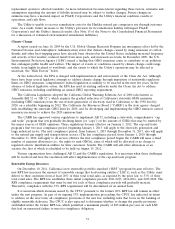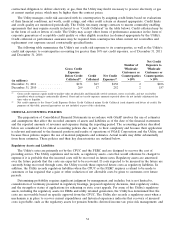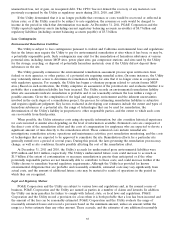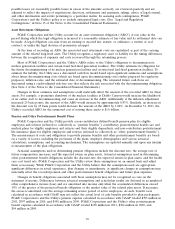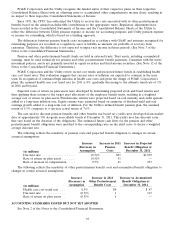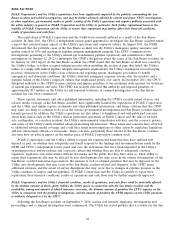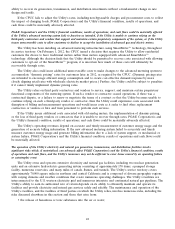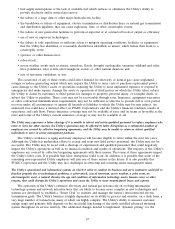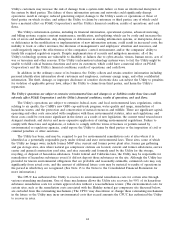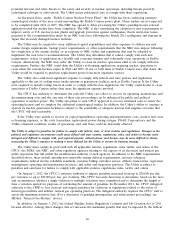PG&E 2011 Annual Report Download - page 45
Download and view the complete annual report
Please find page 45 of the 2011 PG&E annual report below. You can navigate through the pages in the report by either clicking on the pages listed below, or by using the keyword search tool below to find specific information within the annual report.The Utility enters into power purchase agreements, including contracts to purchase renewable energy, following
competitive requests for offers. The Utility submits the winning contracts to the CPUC for approval and
authorization to recover contract costs through rates. There is a risk that the contractual prices the Utility is required
to pay will become uneconomic in the future for a variety of reasons, including developments in alternative energy
technology, increased self-generation by customers, an increase in distributed generation, and lower customer
demand due to economic conditions or the loss of the Utility’s customers to other generation providers. In particular,
as the market for renewable energy develops in response to California’s new renewable energy requirements, there is
a risk that the Utility’s contractual commitments could result in procurement costs that are higher than the market
price of renewable energy in the future. This could create a further risk that the CPUC would disallow contract costs
in the future if the CPUC determines that the costs are unreasonably above market. The Utility also may incur costs
in connection with GHG cap-and-trade regulations adopted by the CARB pursuant to AB 32. The CARB will issue
a fixed number of free emission allowances (i.e., the rights to emit GHGs), to the Utility that will be sold through
the CARB-managed auction for the benefit of the Utility’s customers. The ultimate costs that the Utility incurs to
purchase emission allowances and offsets on behalf of its customers may exceed the value of the auction revenues. It
is uncertain how the Utility’s costs would be affected if federal or regional cap and trade programs are adopted.
The Utility also purchases energy through the day-ahead wholesale electricity market operated by the CAISO.
The amount of electricity the Utility purchases on the wholesale market fluctuates due to a variety of factors,
including, the level of electricity generated by the Utility’s own generation facilities, changes in customer demand,
periodic expirations or terminations of power purchase contracts, the execution of new power purchase contracts,
fluctuation in the output of hydroelectric and other renewable power facilities owned or under contract by the
Utility, and the implementation of new energy efficiency and demand response programs. The market prices of
electricity also fluctuate. Although market mechanisms are designed to limit excessive prices, these market
mechanisms could fail, or the related systems and software on which the market mechanisms rely may not perform as
intended, which could result in excessive market prices. In addition, the Utility may incur costs to implement systems
and software needed to adapt to new market features.
Although procurement costs and costs to adapt to new market features are expected to be passed through to
customers, there is a risk that, as rates rise to reflect these costs, increasing public pressure to reduce rates could
cause the CPUC to disallow some of these costs and PG&E Corporation’s and the Utility’s financial condition,
results of operations, and cash flows could be materially adversely affected.
PG&E Corporation’s and the Utility’s financial results can be affected by the loss of Utility customers and decreased new
customer growth due to municipalization, an increase in the number of community choice aggregators, increasing levels of
‘‘direct access,’’ and the development and integration of self-generation technologies.
The Utility’s customers could bypass its distribution and transmission system by obtaining such services from
other providers. This may result in stranded investment capital, loss of customer growth, and additional barriers to
cost recovery. Forms of bypass of the Utility’s electricity distribution system include construction of duplicate
distribution facilities to serve specific existing or new customers. In addition, municipalities could exercise their power
of eminent domain to acquire the Utility’s facilities and use the facilities to provide utility service to the
municipalities’ residents. The Utility may be unable to recover its investment in the distribution assets that it no
longer owns. The Utility’s natural gas transmission facilities could risk being bypassed by interstate pipeline
companies that construct facilities in the Utility’s markets, by customers who build pipeline connections that bypass
the Utility’s natural gas transmission and distribution system, or by customers who use and transport liquefied natural
gas.
Alternatively, the Utility’s customers could bypass purchasing electricity from the Utility by becoming direct
access customers of alternative energy suppliers or becoming customers of governmental bodies registered as
community choice aggregators to purchase and sell electricity for their residents and businesses. Although the Utility
is permitted to collect a non-bypassable charge for generation-related costs incurred on behalf of these customers, or
distribution, metering, or other services it continues to provide, the fee may not be sufficient for the Utility to fully
recover the costs to provide these services. Furthermore, if the former customers return to receiving electricity supply
from the Utility, the Utility would be required to meet their electricity needs at costs that could exceed the rates
charged to these customers.
A combination of technology-related cost declines and sustained federal or state subsidies make distributed
generation a viable, cost-effective alternative to the Utility’s bundled electric service, further threatening the Utility’s
41


